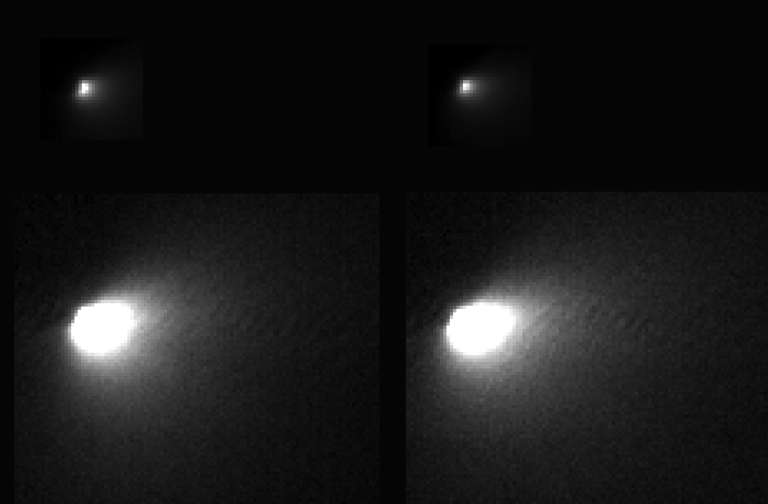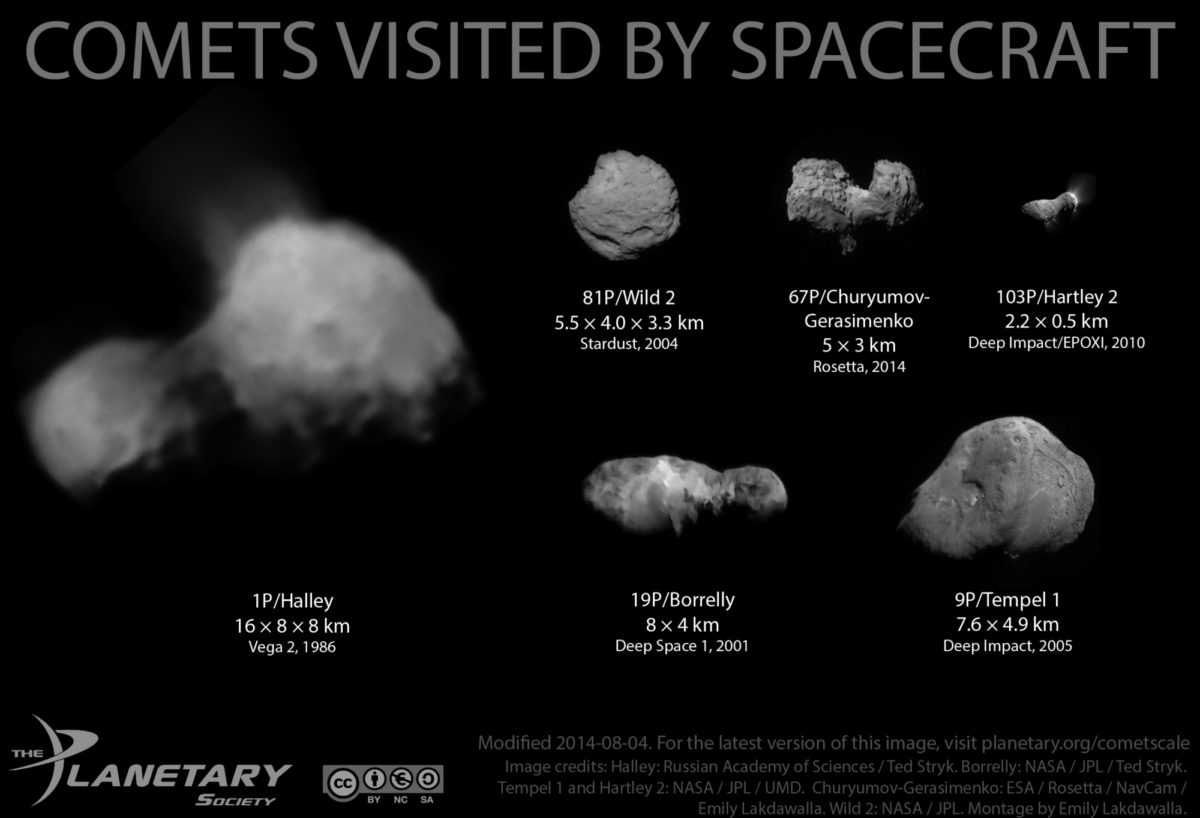Emily Lakdawalla • Oct 20, 2017
#DPS2017: Progress report on Mars Reconnaissance Orbiter images of comet C/2013 A1 Siding Spring
Three years ago, on October 19, 2014, comet C/2013 A1 Siding Spring passed within 138,000 kilometers of Mars. No fewer than seven active Mars spacecraft pointed instruments at the cometary visitor, which was thought to be on its first trip in toward the Sun from the Oort Cloud. The newly arrived MAVEN got to do some amazing science even before their mission was to start, watching a cometary coma collide with the Martian atmosphere. Apart from MAVEN, the most anticipated data set was from Mars Reconnaissance Orbiter’s HiRISE camera. As the largest telescope ever sent beyond the Moon, it stood to capture well-resolved views of the comet’s nucleus.
The HiRISE images, when we received them, turned out to be a little difficult to interpret. At this year’s Division for Planetary Sciences meeting, Tony Farnham reported on work he has been doing to process the HiRISE images in order to understand them better. This isn’t an Earth-shattering result – it’s just work in progress – but I like the fact that it is a Mars mission observing a comet and also that it’s a fun opportunity to show how professionals employ image processing to do science, so it wraps together many of the things I enjoy about work presented at DPS.

Before I get to Farnham’s work, let me set the scene by copying here what I wrote about the HiRISE images back in 2014:
HiRISE … successfully imaged the comet at very high resolution. But the photos don't show as many pixels across the comet as predicted, because the comet turned out to be smaller than predicted. Although the comet's small size is a little disappointing for the images, it's actually quite an exciting scientific result, probably. The size of unresolved solar system objects is estimated by taking its absolute magnitude (which can be measured reasonably precisely) and assuming an albedo, or reflectiveness, of its surface. All the comets we've ever seen up close are exceedingly dark, with albedos around 5 percent, give or take a couple percent. The fact that Siding Spring turned out to be smaller than predicted means we guessed its albedo wrong. Its surface is more reflective than we predicted. Which is wonderful, because it's consistent with the hypothesis that comets are usually dark because the Sun has baked away brighter ices, and that they start out their cometary lives much brighter. So we may have just learned something about the nature of bodies that are too far away from the Sun for us to see. (I am hedging all of my language here because I would like to see a bright comet nucleus albedo confirmed by more quantitative analysis and, ideally, evidence from another one of the spacecraft.)
I find the HiRISE images to be a little bit difficult to interpret. One important piece of information is that the phase angle of the observation is about 110 degrees, so we're seeing the nucleus of the comet in a crescent phase. That is, most of the nucleus of the comet that is in the field of view is actually the night side. The bright blob is not the nucleus; the nucleus is about a quarter of the bright blob, and about three quarters dark pixels next to the bright blob. The sunlit crescent of the comet is hard to differentiate from the brightest inner part of the coma.
What makes these images so difficult is the coma. As a fresh comet, it was super active, its ices rapidly vaporizing as it approached the Sun. Farnham’s work is to try to remove the coma from the images in order to see the nucleus better. His initial analysis uses a straightforward process explained on the slide below (thanks to Tony for sharing his slides with me):
- Locate the center of the comet in the original HiRISE image
- “Unwrap” the image – reproject it from polar to rectangular, into a projection that puts the comet’s center at the bottom of the image and gets increasingly far away from the comet as you go up (this is like taking a globe and making a rectangular map out of it – the comet is spread out across the bottom of the image the way Antarctica gets spread out at the bottom of the map)
- The unwrapped image is brighter at the center and fades as you go away from the center – that’s mostly the signal of the coma. So Farnham made a model of the coma by fitting curves to it. He re-wrapped up the coma model back into polar projection. You can compare the original image and model image at the bottom of the slide.
- Finally, he subtracted the coma model from the original image. What’s left is a smooth background wherever the coma used to be (which is good, because that means he did a good job subtracting out the coma), and then a comma-shaped bright splotch that is leftover signal of the comet’s nucleus.
HiRISE actually took five sets of observations of the nucleus from different distances and points of view. Farnham applied the same analysis to all those images and came up with the following images which, although still somewhat blurry, at least all consistently show a comma-shaped nucleus. (NOT a coma-shaped nucleus. That would be confusing. A comma-shaped nucleus, like the punctuation mark.)
All right, so, given a slightly better view of the comet, what can you do with that? Farnham pointed out that the consistent comma shape indicates that HiRISE did resolve the nucleus and that the nucleus is elongated so that its illuminated crescent is not symmetrical. Here is a simulated view of an elongated, ellipsoidal comet nucleus rotating through the points of view from which HiRISE saw it that agrees moderately well with the coma-subtracted images:
He found the short axis to have a diameter of about 700 meters, and the long axis – if he has the rotational pole correct (there are three published possibilities, but only one seems consistent with the HiRISE observations) – would be about 1000 meters.
This was a preliminary bit of work, a proof of concept. Next he needs to go back and create a unique model of the coma for each image. He notes that in at least a couple of the images there still appears to be a jet feature, which would happen if the jet is not radial to the center of the comet. Once he’s taken more care with the coma modeling, he should be able to impose tighter constraints on the size and shape of the nucleus, its albedo, and maybe even its color (since the HiRISE observations were in color).
How does 1000 by 700 meters fit in with the population of comets we’ve visited with spacecraft before? It’s the smallest we’ve ever resolved with a spacecraft, about half of Hartley 2:

More to come next week from DPS!
Support our core enterprises
Your support powers our mission to explore worlds, find life, and defend Earth. You make all the difference when you make a gift. Give today!
Donate

 Explore Worlds
Explore Worlds Find Life
Find Life Defend Earth
Defend Earth




